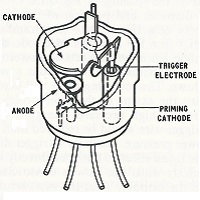Introduction
As Nick Stock explains This kit was never meant to be a kit! Let me explain. The genesis of it came from my desire to build one of Grahame's original trigger tube clocks as detailed on his website. However, as was quickly pointed out, this clock had a few drawbacks, not least of which is that operation in the absence of light was unreliable given the trigger tube used (XC18). Enter Trigger Tube Clock II which spawned a few board sets that employed the Z700U trigger tube. This variant possesses a keep alive cathode to ensure that the trigger gap ignites when "asked" to even in the absence of daylight photons. The kit described in these pages is a revamped version with a few modifications, including different inter-board connectors and unifying the power supply and timebase onto a single larger board. It is also the result of a lot of enthusiasm from people wishing to build their own. Apart from that, it's electrically the same (mostly) as its prior incarnation. The design uses 95 valves and neon filled tubes. It also uses 347 resistors, 204 capacitors, a custom wound mains transformer and other bits and pieces, so it is not a small project. However, there is no microcontroller or its necessary software in sight. It uses the filtered and conditioned mains frequency as a timebase for counting. With a few component changes, the clock will operate with either 50 or 60Hz mains and operate on 230V or 115V power. Obviously there are high voltages with over 400V DC present in the clock and as such it is definitely NOT a beginners electronics project.
For safety, the clock must be earthed correctly and any exposed metal parts earth (ground) bonded. This also applies to any switches used in the clock that have metal bodies. Even though the correctly voltage rated switches should only be used, isolation failure should be guarded against and we recommend that they be mounted to a grounded metal plate for safer operation. Under no circumstances should the power supply be modified for direct mains operation and the transformer omitted.
The fully built clock also generates quite a bit of heat, so if you plan on making a case for it (you should, to avoid probing fingers…) then take that into account to avoid premature failure or worst of all, the possibility of a fire!
Quick Links
- introduction
- references
- bulding
- power supply & 1Hz timebase
- seconds & minutes display
- hours display
- inter-board wiring
- clock longevity
- switch selection
- add-on boards
- Annex I trigger tubes circuits
- Annex II display design by JB Dance
- link to first trigger tube clock
- link to second trigger tube clock
References
This clock is based on material published in books or based on designs by others found on the internet. The key referenced materials are:
- A bulletin from Philips "Subminiature Trigger Tubes Z70U Z70W"
- A section in "Electronic Counting Circuits" by JB Dance and reproduced below in Annex II
- By Morris Odell "Vacuum Tube 1Hz Relay Timebase"
- Mullard Technical Handbook "Cold Cathode Tubes" 1963
- "Cold Cathode Tube Circuit Design" DM Neale D.Van Nostrand Inc 1965, chapters 3, 4 & 5 in particular
See also Annex I below which contains a longer description of how trigger (or relay) tubes work.
Quick LinksBuilding
There are 4 main boards that comprise the clock. One PSU-Timebase board, two "minutes-seconds" boards and one "hours" board. These are all connected up by means of screw terminal connections. Each of the counter boards have header pins for connecting their respective nixie tubes with a 430V DC connection to the nixie anode (with the necessity of a suitable current limiting series resistor, this will depend on what type of nixie tube you wish to use). There are also connection points for driving colons and a variety of ways you can fashion switches to control their operation.
Quick LinksPower supply & 1Hz timebase
This is the beating heart of the clock, using valve based regulation of the mains power to generate the following:
- c. +430V DC for the hours/minutes/seconds count and display boards
- c. +150V DC and a stabilised +280V DC for the timebase, reset and other general functions
- 6.3V RMS AC for the valves with heaters
- c. 450V RMS AC for two electrode neon bulbs for colons (MTX90 thyratrons work well for this purpose)
- c. 200V peak half-wave pulses for the timebase
- c. -30V DC bias supply
No off-the-shelf transformer was found that could deliver the requisite secondary windings, so a custom wound was sourced. The specification is:
- Primary: 110/230V dual AC RMS 50/60Hz
- Secondary 1: 400 - 0 - 400V AC RMS @ 50mA
- Secondary 2: 6.3V AC RMS @ 1.5A (2.1 A if optional Dekatron Pendulum board is added)
A single primary transformer is OK for both 115V or 230V operation. However, the Dekatron pendulum extension (see Annex) requires a 115V AC supply. This is fine when a 115V mains supply is used but for a 230V mains supply, dual primaries are required to be able to use the mains transformer primaries as an auto-transformer to obtain the necessary 115V AC. The Dekatron pendulum add-on also necessitates a 2.1A rated 6.3V heater winding as this optional board has another EZ90 rectifier valve. If you decide to use a different transformer than outlined, then a few resistor values in the PSU may need adjustment. See notes at the end of the PSU/Timebase parts list for modifications needed for 50Hz operation.
Schematics
Click for a larger image:
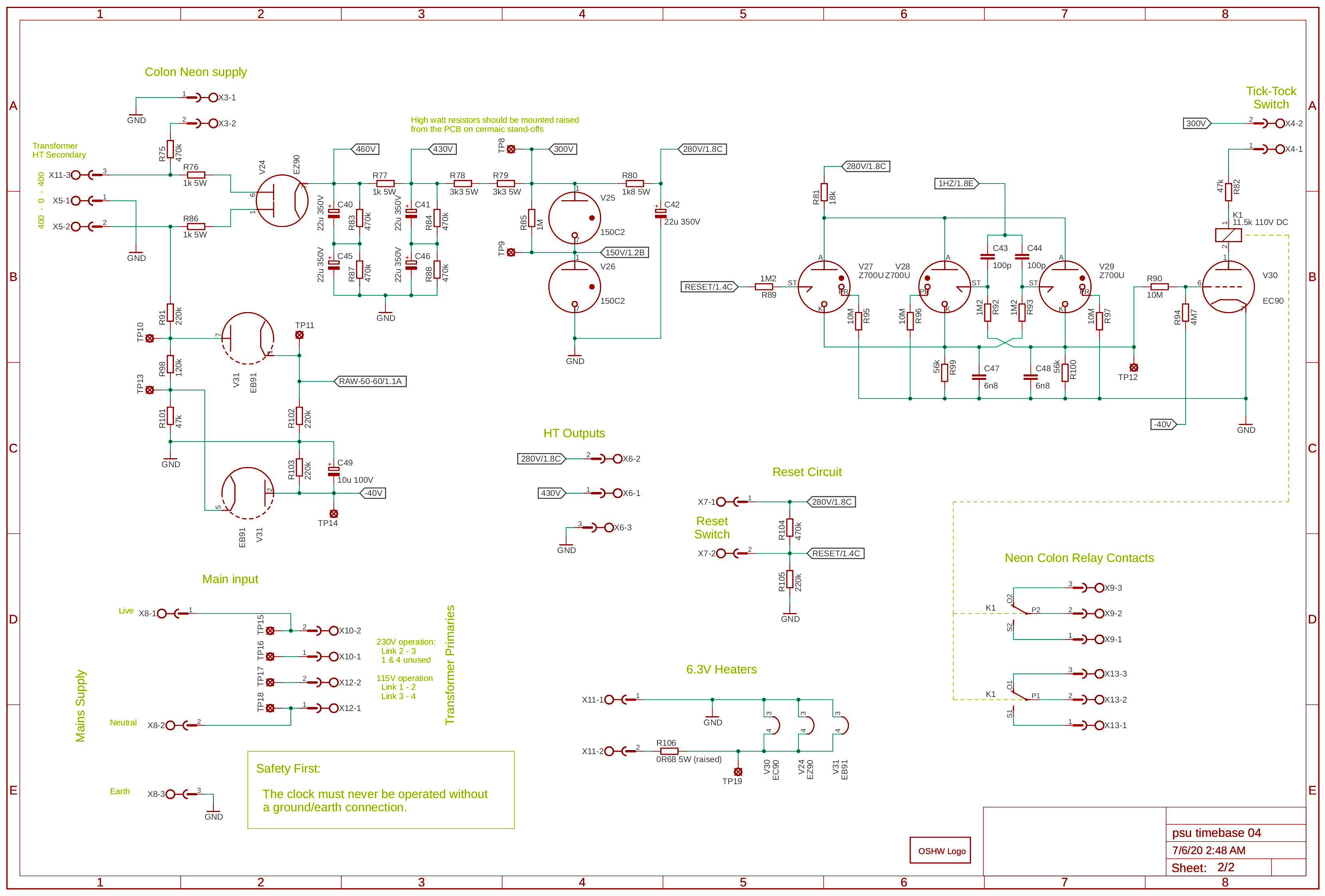
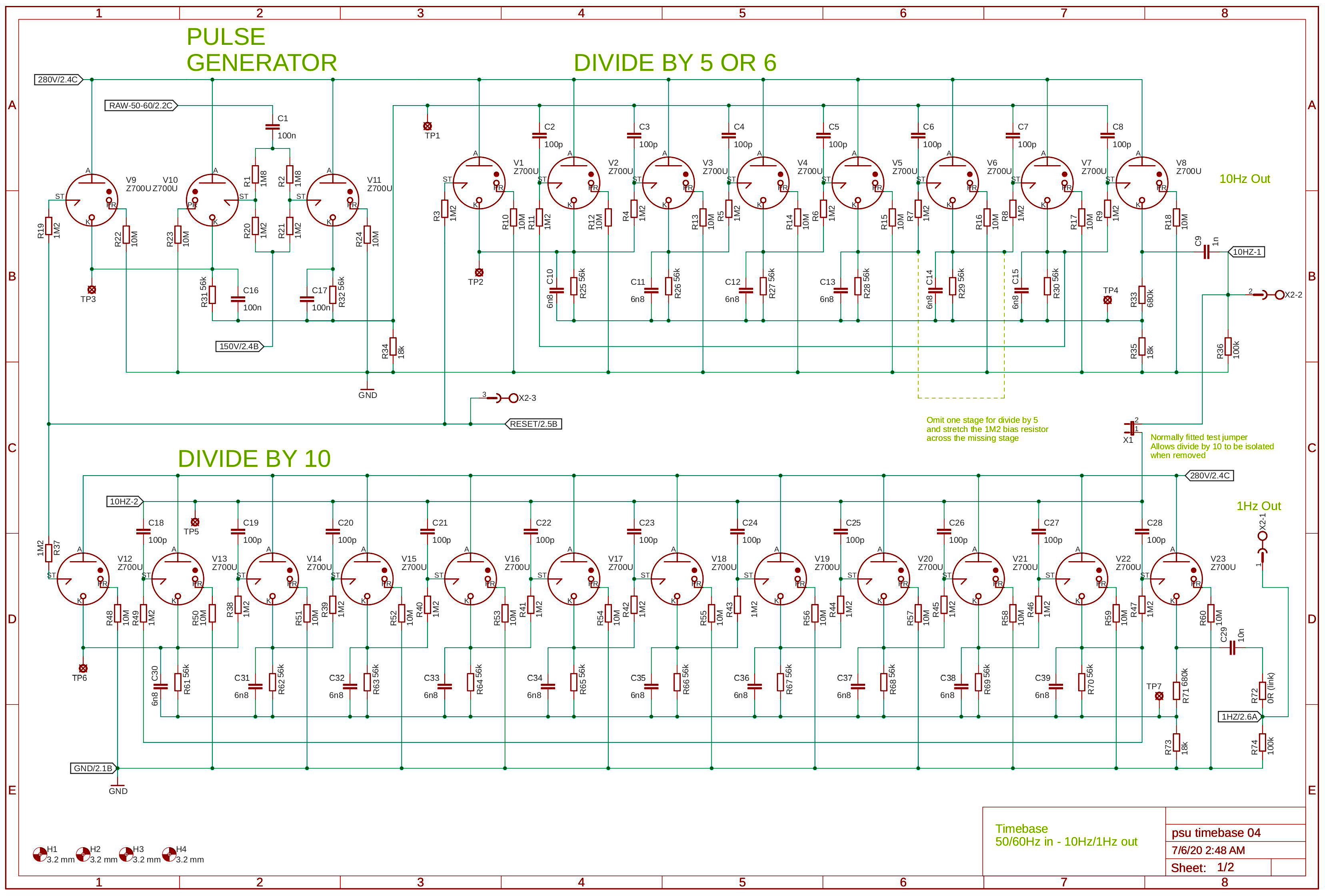
Specifically, referring to the schematics and description that follow:
- The rectifier anode resistors (R76 & R86) should be adjusted to give about 460V DC at the cathode of the rectifier. The operating envelope of the EZ90 rectifier must not be abused and the resistance of the half secondary winding plus the resistor value used must exceed 525R
- The filter/dropper resistor (R77) should be adjusted to give 430V DC at the filter exit (output connector X6)
- The heater series resistor (R106) should be adjusted to give 6.3V AC RMS on the heaters including potential replacement with a wire link if the voltage from the transformer is exact or low
- The potential divider resistor (R91) should be adjusted to the highest value possible that gives sufficient half-wave pulse peak voltage (Test point 10) to reliably trigger the timebase pulse-shaper
It should not prove necessary to adjust the other dropper resistors R80 and R84.
The PSU board also contains the circuits to drive the nixie tube separator colons (two electrode neon bulbs work well for this, an option is to use MTX90 thyratrons, more on this below), generate the correct reset voltages and a once per second relay click to generate a "pleasing" tick-tock sound and optionally flash the separator colons. The implementation of colon 10 separators has been deliberately left flexible. This is to allow some customisation of the clock by the builder. Options for colons are discussed further along in the manual.
V24 is the main rectifier double diode valve and after smoothing provides +430V for the count and nixie display boards. After a further dropper resistor, V25 and V26 provide stabilised +300V and after a further dropper resistor, +280V is provided for the timebase board, reset and colon flashing counters.
One transformer secondary is used to feed the colons with AC power. This means that both electrodes in the colons glow. The colons can be omitted, be permanently illuminated or made to flash at 0.5Hz (i.e. on for 1 second, off for 1 second) using the contacts on relay K1. The other transformer secondary is used to feed a potential divider. The first tap is rectified by one half of an EB91 double diode but is un-smoothed. This valve diode provides half-wave pulses at 50 or 60Hz to the timebase section. A lower tap on the potential divider is rectified by the other half of the EB91 diode. This rectifier is smoothed and produces about -30V DC as a bias voltage to the grid of V30 holding the tube fully cut-off normally.
V28 and V29 form a binary counter that changes state once per second. The cathode of V29 drives the grid of V30 so that V30 conducts and relay K1 closes. V27 is a reset tube in parallel with V28 so that the relay K1 is de-energised during a reset. This circuitry accomplishes two things: a distinctive tick-tock sound as the relay is energised and de-energised and the relay contacts can be used to flash the colon neons! V27, V28, V29, V30, K1 and their associated resistors and capacitors are optional and are not required for the clock to function. Also, an optional switch, S3, in the anode circuit of V30 can be used to silence the relay (and this will also prevent the colons from flashing).
What follows is a short construction guide for each board for a basic clock (PSU/Timebase, 2 of the Seconds/Minutes boards and 1 Hour board) with pictures, schematics and parts lists. Then follows a set of wiring diagrams on how to hook it all up and let it rip (hopefully). It is also HIGHLY recommended that you test your Z700U trigger tubes before installing them. We have a small tester board for such a necessity, but you will need to have access to a suitable HV bench supply.
Construction
For a comprehensive list of the part numbers and ordering info, please see the spreadsheet on the Dropbox. Construction is pretty straightforward, solder the smallest height components first working your way up to the largest (valve bases). See photos that follow for some specific installation commentary. Note that links at the transformer input need to be installed for either 115 or 230V operation.
Take your time to install the trigger tubes nice and neatly using the 3D printed spacers. If you're printing them yourself, then use a transparent PLA as that allows more of the neon glow to appear when the clock is in operation.
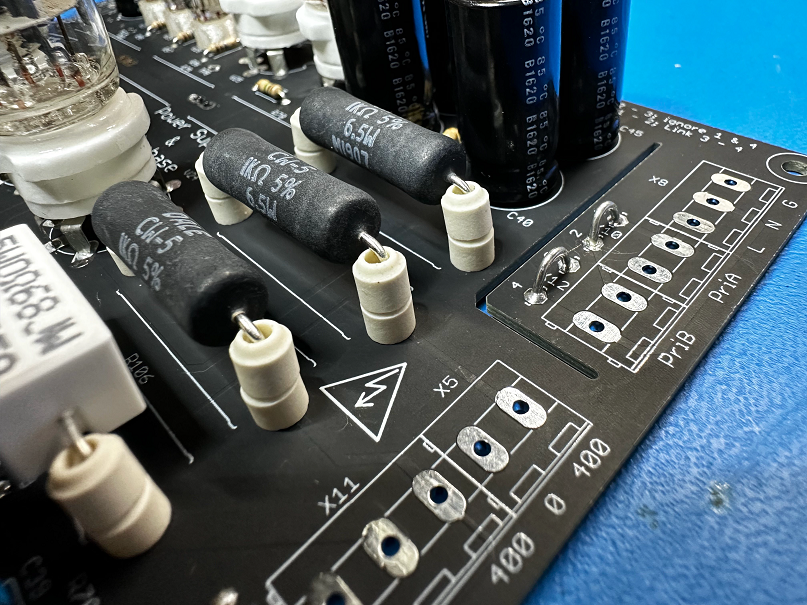
Note the ceramic spacers on the high wattage resistors - All the 5W resistors should be elevated from the PCB as they generate a lot of heat.
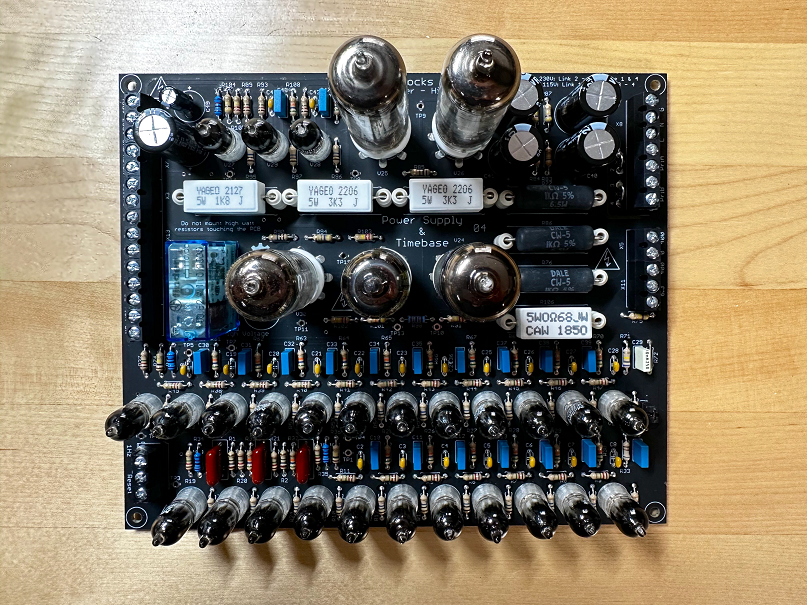
The completed PSU/Timebase board - 60Hz operation - Note the links for 115V operation on this one at the top right and the 3D printed spacers for the Z700U trigger tubes. If you plan on displaying the clock, take time to orient all the resistors the same way around and make the board as neat and professional looking as possible.
Notes on 50Hz Operation
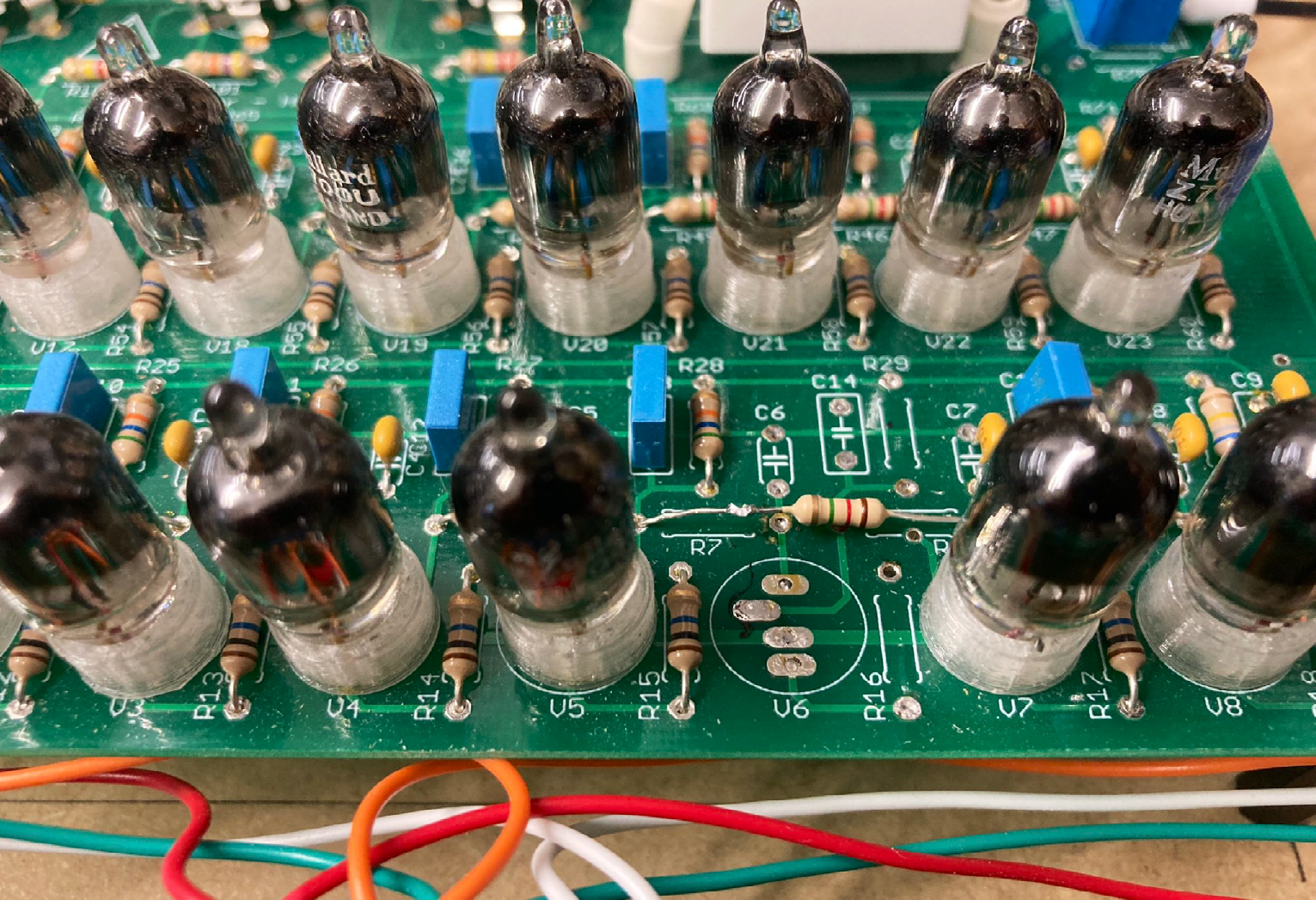
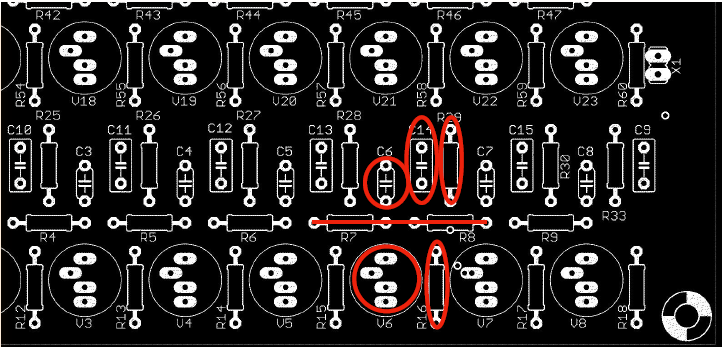
For those not living in 60Hz land, the timebase board needs a few components omitting for 50Hz operation. Trigger tube V6 should be left out of the chain to accomplish this (turns the chain from a divide by 6 into a divide by 5), including its respective resistors and caps. Bridge the missing trigger tube with a 1M2 biasing resistor as pictured here.
Circuit Operation
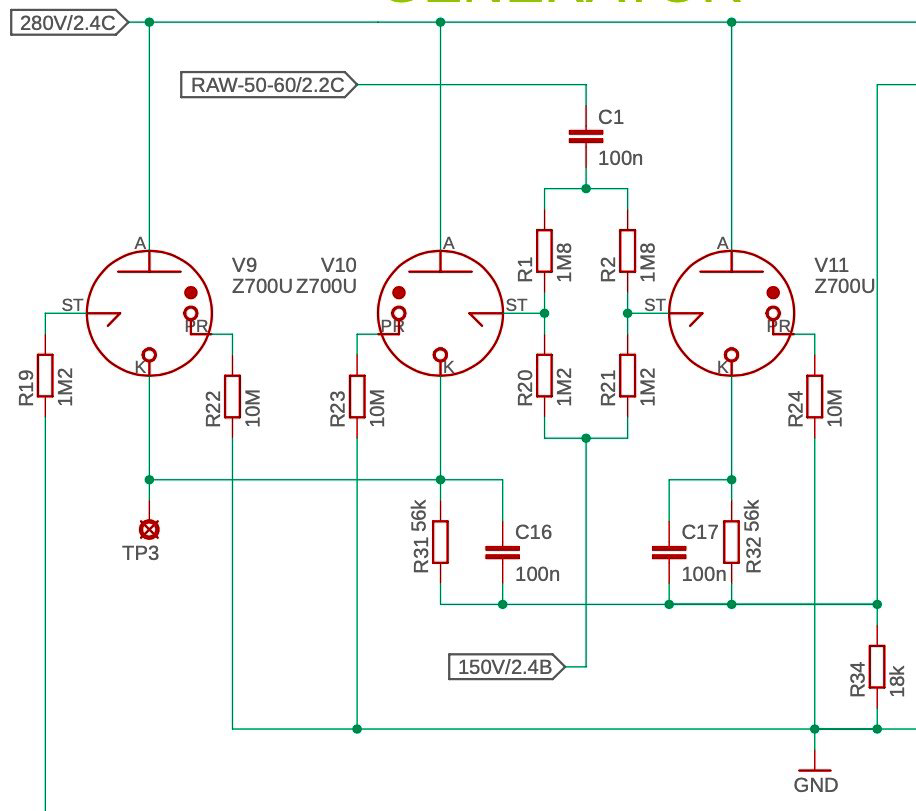
The timebase board takes rectified and unsmoothened positive half-wave pulses at mains frequency from the power supply section. The schematic is based on Figures 32 and Figure 33 in the Phillips reference. A few changes have been made, mainly to the power supply and reset arrangements.
V10 and V11 form a flip-flop circuit to deliver pulses into the counter rings. The relatively long time constant of the cathode circuits prevent the flip-flop being triggered more than once during a half-wave pulse. Pulses across the common cathode resistor are of the correct amplitude and shape to feed into the first counter ring. V9 is used to start or reset the flip-flop.
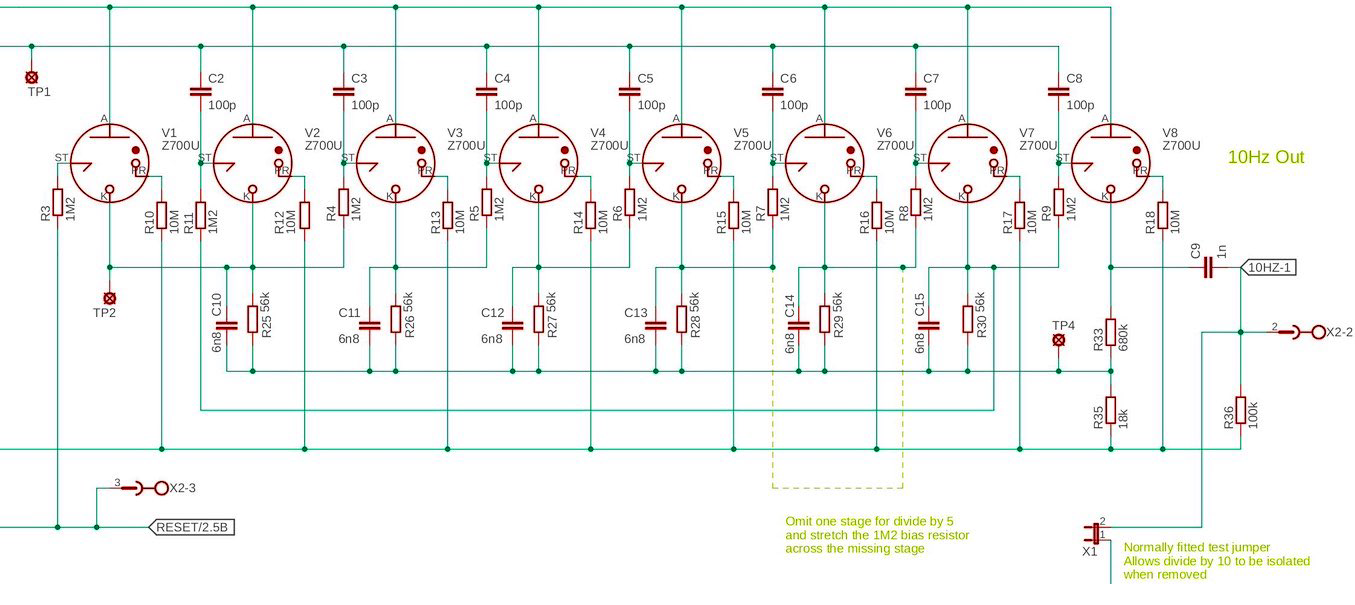
V2 to V7 form a divide by 6 counting ring for operation with a mains frequency of 60Hz. For operation with a mains frequency of 50Hz one of the tubes (and associated resistors and capacitors) is omitted to form a divide by 5 counting ring. Any of the tubes can be omitted except V2 and V8 as these have other circuits attached. V1 has common cathode and anode connections with V2 and is used to start or reset the ring by pulsing its trigger electrode (this technique is used in many places in this clock design). V8 is the "carry" detector and is used to drive the next ring with a 10Hz signal by passing one pulse every six (60Hz mains) or five (50Hz mains) pulses received.
 V13 to V22 use the same basic circuit as the first ring except it has 10 stages to form a divide by 10 counting ring. V12 is the ring start/
reset tube and V23 is the carry tube which passes 1Hz pulses to the seconds counting/display board and to the PSU board to operate
the tick-tock relay flipflop.
V13 to V22 use the same basic circuit as the first ring except it has 10 stages to form a divide by 10 counting ring. V12 is the ring start/
reset tube and V23 is the carry tube which passes 1Hz pulses to the seconds counting/display board and to the PSU board to operate
the tick-tock relay flipflop.
Printed Circuit Board
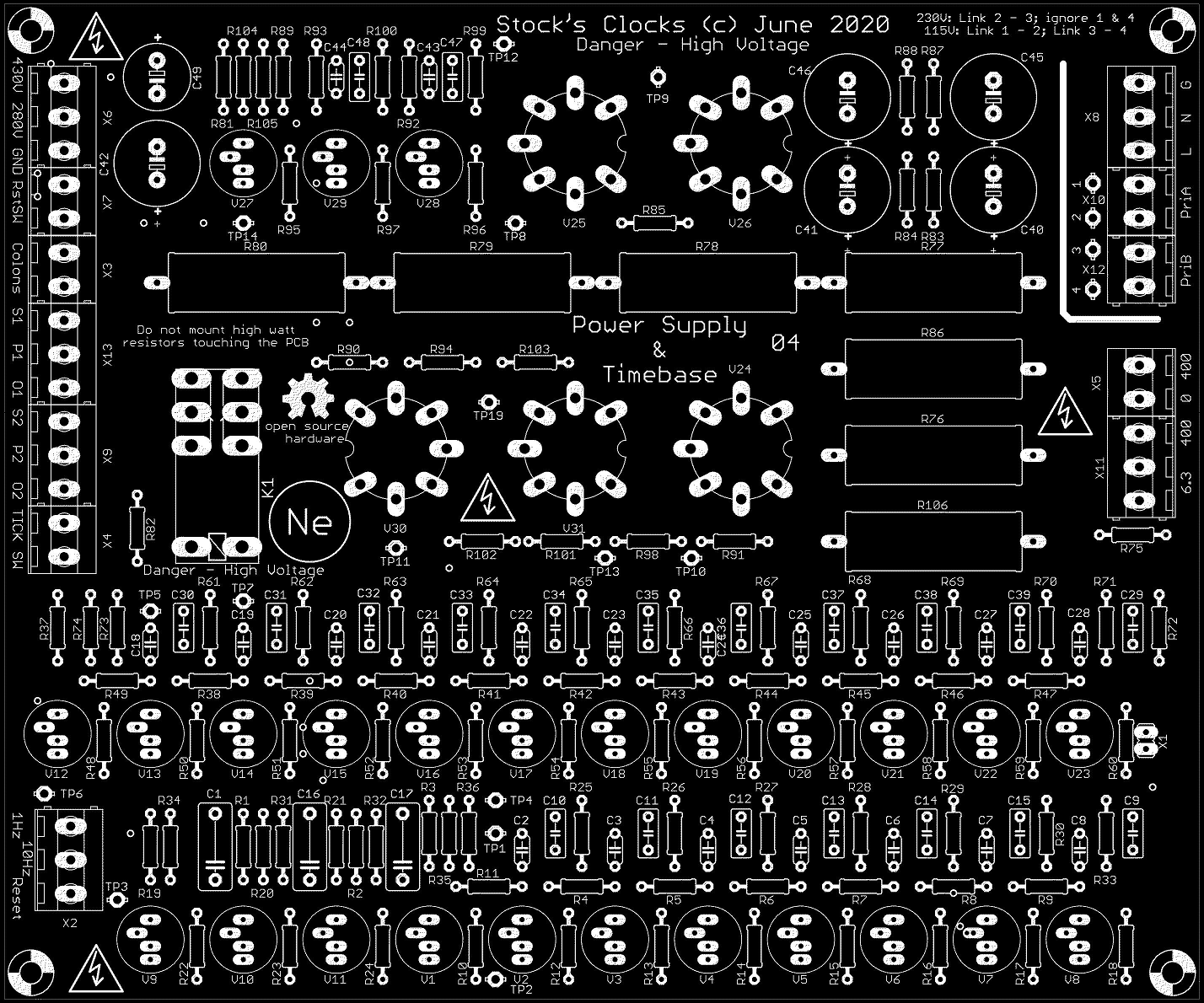 Quick Links
Quick Links
Seconds & Minutes Display
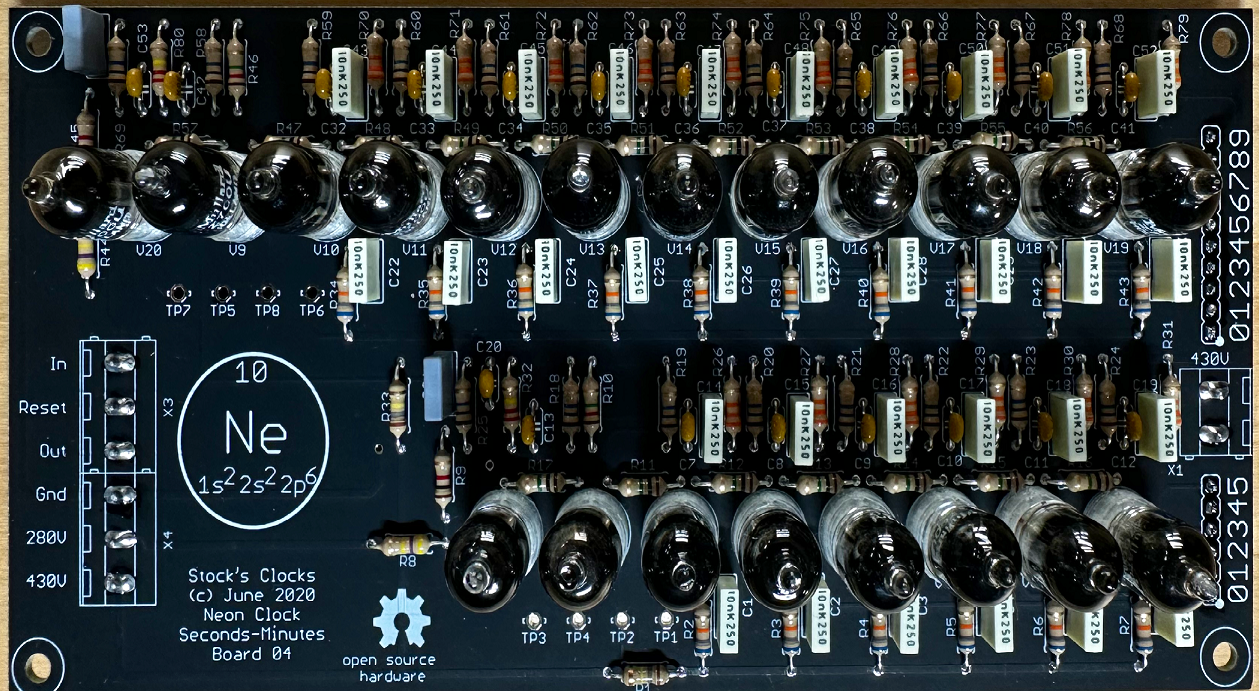
The minutes and seconds board both count and display 00 to 59 and are therefore identical. The seconds board takes the 1Hz signal from the timebase board and sends one pulse per minute to the minutes count and display board. In turn the minutes board sends one pulse per hour to the hours count and display board
Schematic
Click for a larger image:
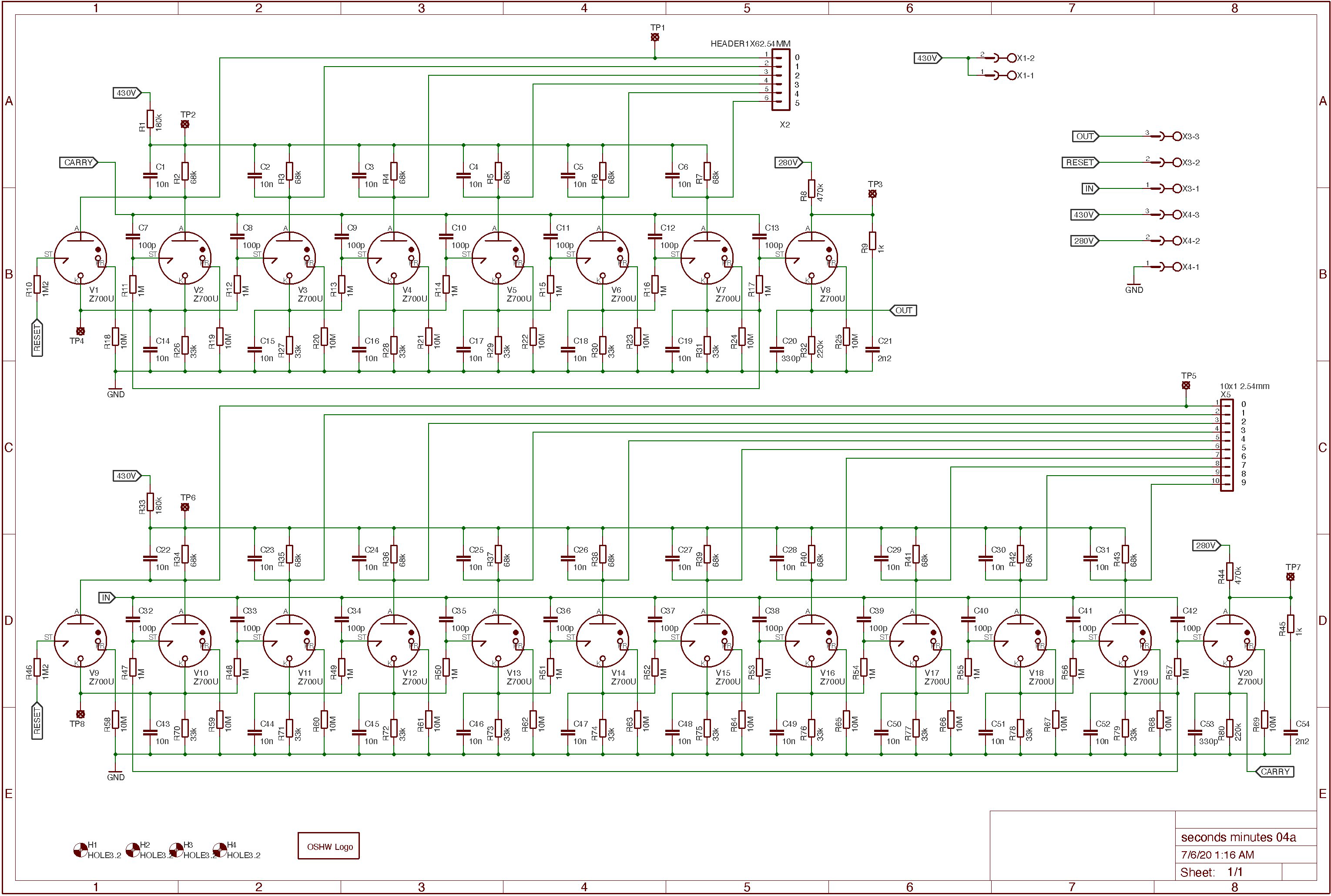
Circuit Operation
V10 to V19 are the ten units count and display ring stages. V9 is in parallel with V10 and is used to reset the ring to 0. V20 is the carry detector and sends a pulse to the tens ring when the units ring count and display is changed from 9 to 0. The tens count and display ring is the same as the units ring except it has only 6 stages. V2 to V7 are the stages, V1 the reset to 0 tube and V8 the carry detector tube which sends a pulse to the next board when the display changes from 5 to 0.
Printed Circuit Board
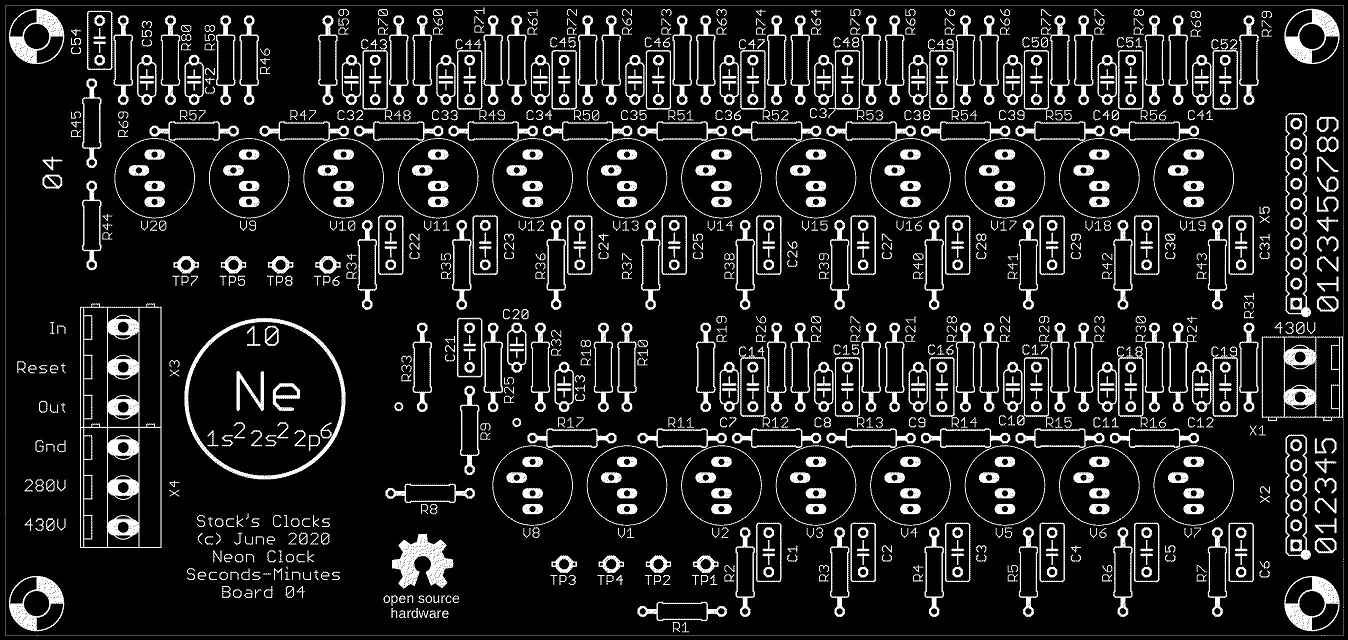 Quick Links
Quick Links
Hours Display
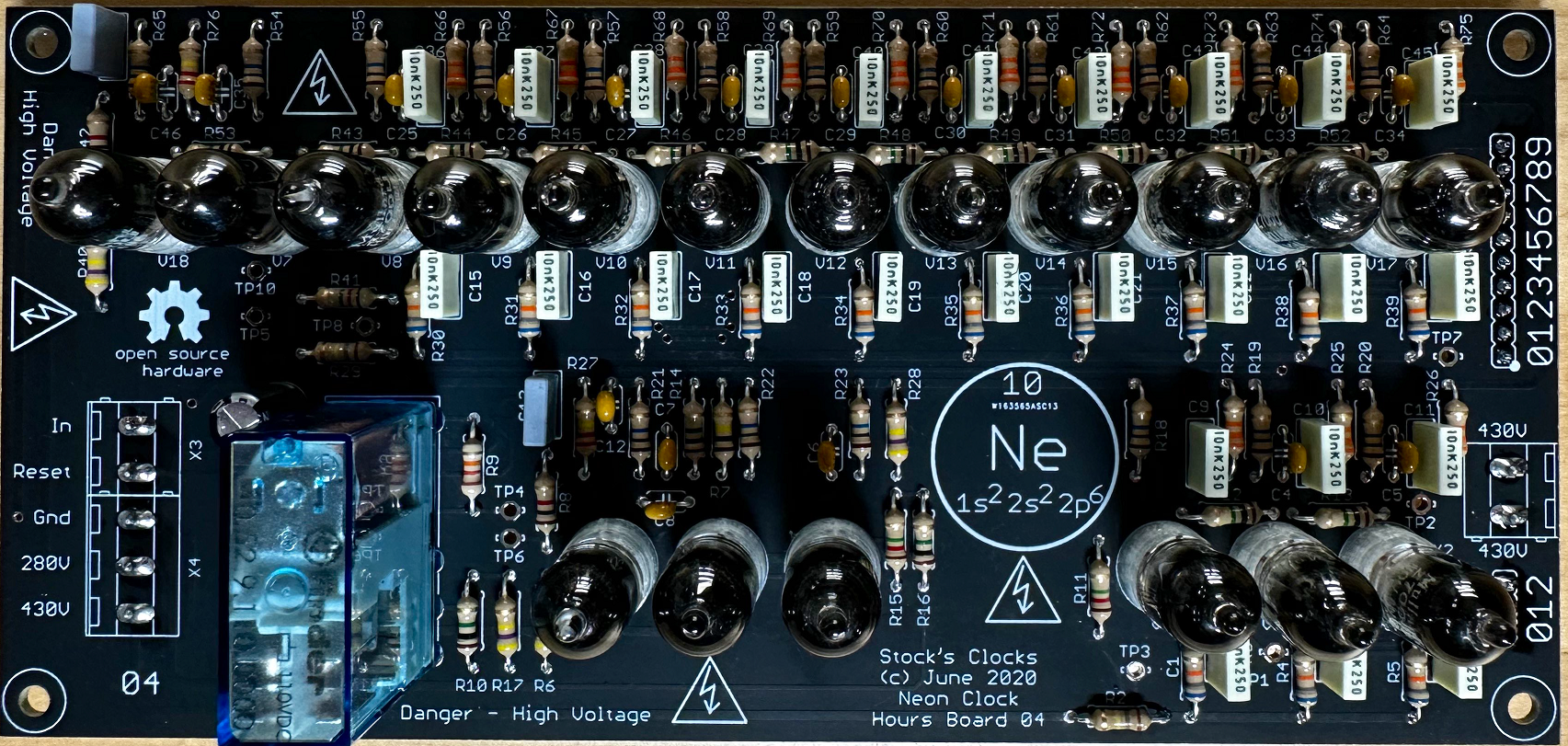
This board takes one pulse per hour from the minutes count and display board.
Schematic
Click for a larger image:
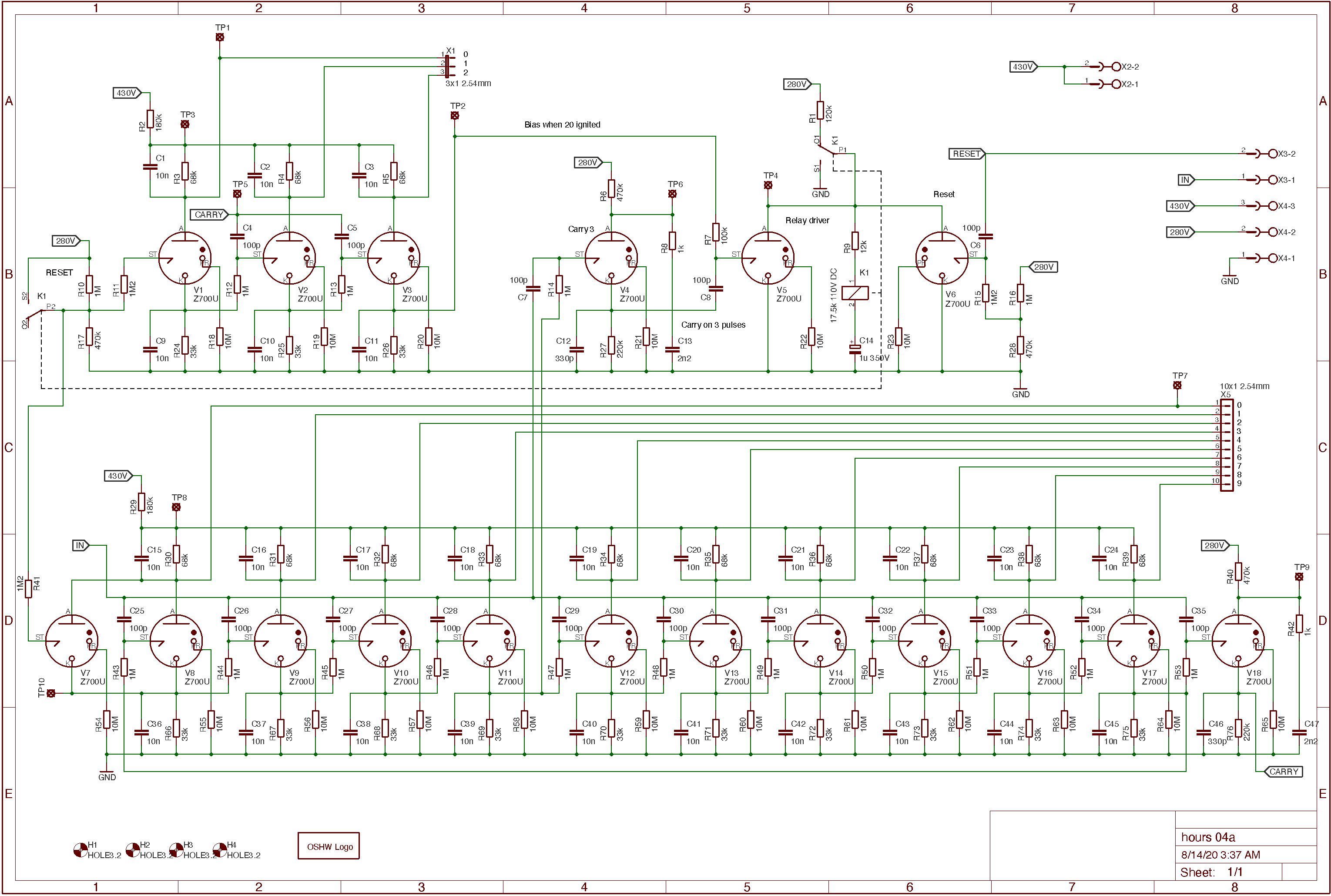
Circuit Operation
It counts and displays hours in the range 00 to 23. The board is different to the previous board in that the count from 23 to 24 must be detected and the count reset to 00. Whereas the seconds and minutes just use simple ring counters.
Printed Circuit Board
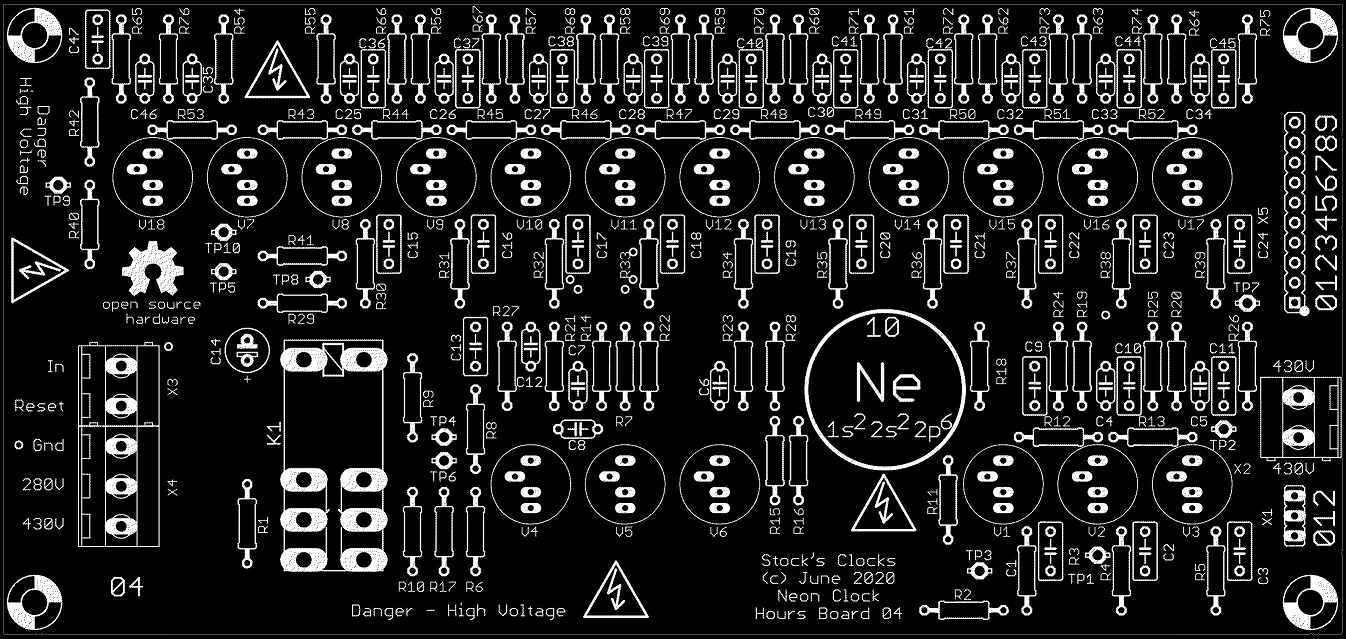
Just an idea for a 12 hour display
An alternative to counting and displaying 00 to 23 is to count and display 01 to 12 hours. This could be accomplished with a design that has a units ring of 10 (0 to 9) and a tens counter of 2 (0 and 1). The design must detect the carry from 12 to 13 and reset the board to 01. With a fairly complex multipole switch it should be possible to have a clock that can be switched between displaying 00 to 23 and 01 to 12. Lastly, a flipflop and two neon bulbs could be added as AM/PM indictors. The flipflop would change state when a count of 12 is detected. This is yet to be contemplated for another Trigger tube clock board design and probably won't see the light of day.
Quick LinksInter-board wiring
Make sure to use 600V rated wire where needed and it is recommended that terminations screwed into the terminal blocks use bootlace ferrules.
Power Wiring Diagram
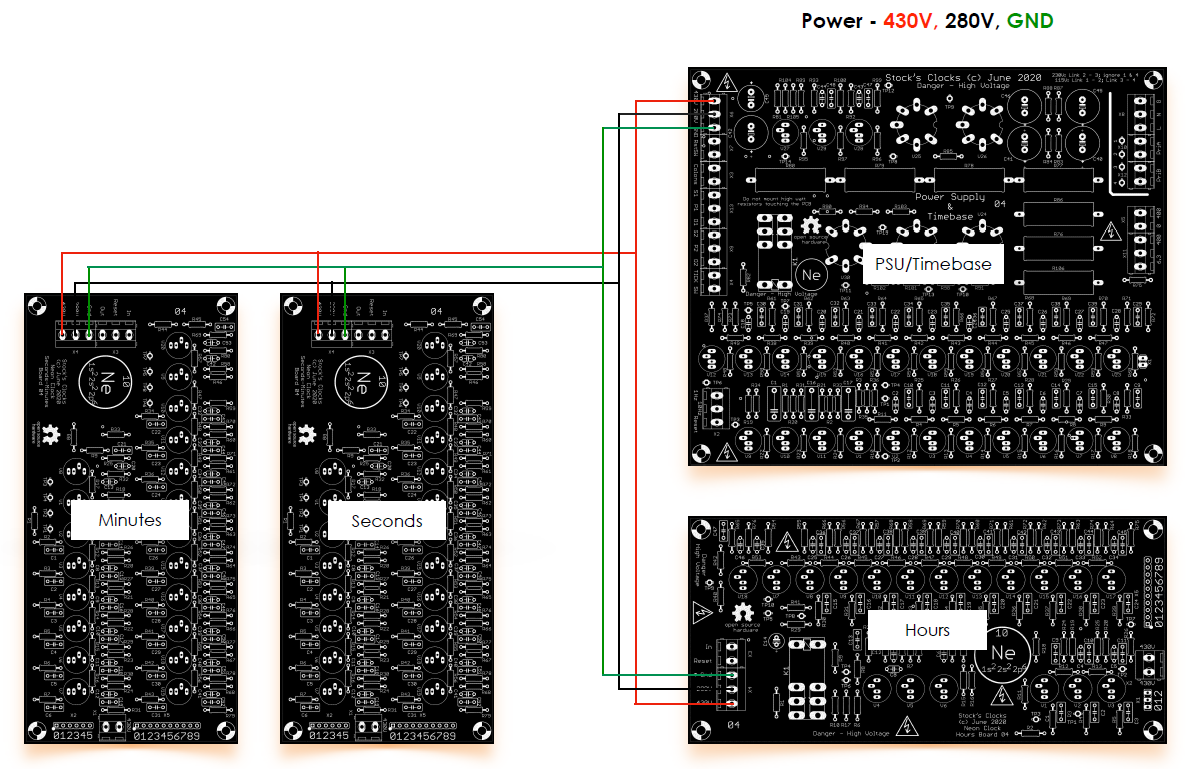
Reset Wiring Diagram
Closing the momentary reset switch resets the connected boards.
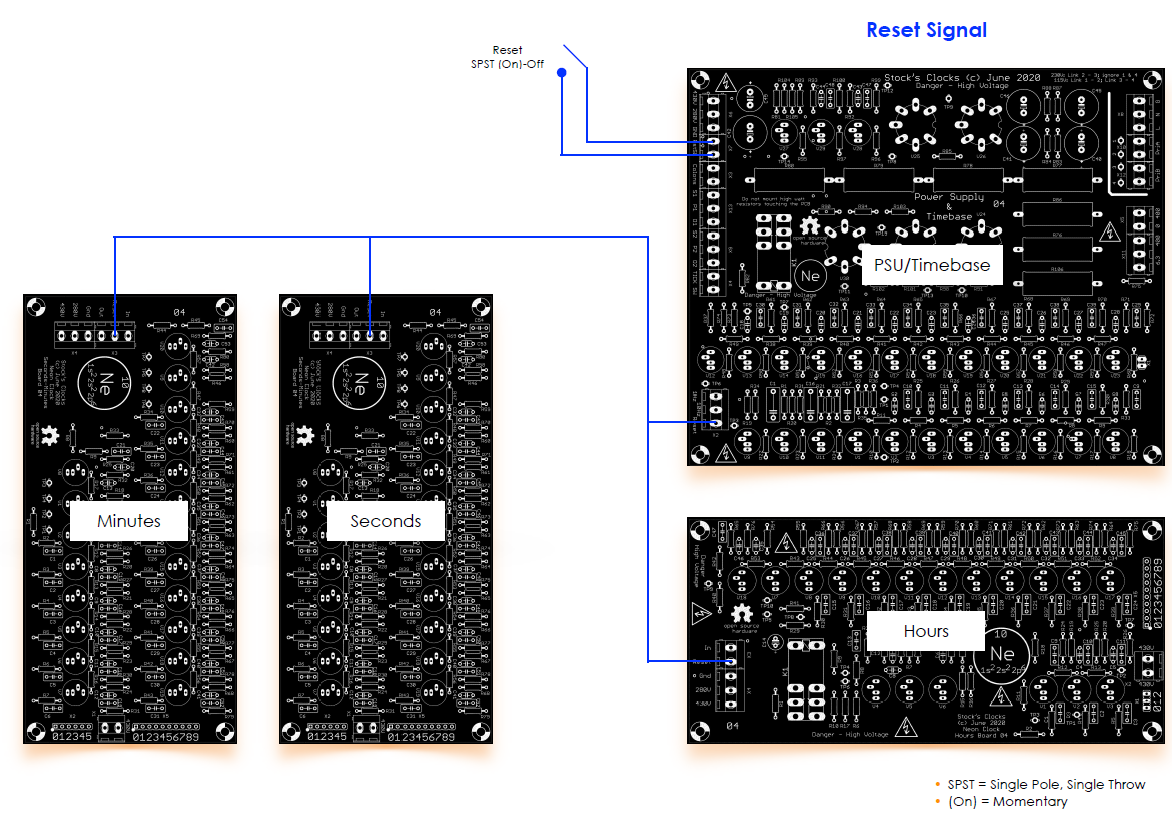
The reset switch should be a momentary action toggle switch or push button. It should be protected from accidental operation or the current clock time will be lost.
Timing Wiring Diagram
This wiring allows the clock to be set by funnelling the 1 Hz timing pulses individually into either the minutes or hours boards by setting the switches appropriately.
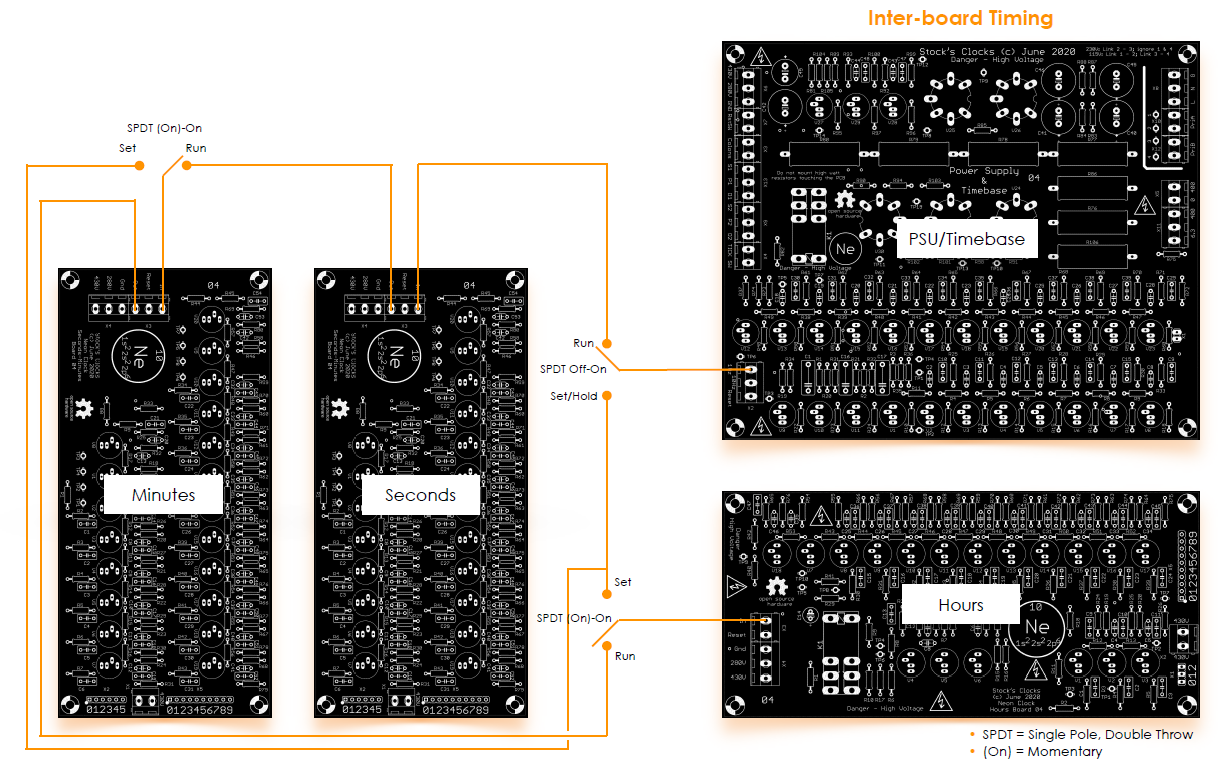
This wiring transfers timing pulse signals between the boards and three switches allow the clock time to be set. The switches are shown in their normal operating position. To set the time on the clock the run/set switch is operated. This disconnects the 1Hz pulses from the seconds board input and so the clock ceases counting. The reset switch (see above) can be momentarily pressed to put the clock in a known state. The fast minutes switch can be operated to send 1Hz pulses into the minutes board so the minutes board will count quickly and the switch can be thrown back when the minutes displayed are correct. The fast hours is operated in the same way to quickly advance the hours displayed. Finally, the run/set switch is thrown back to restart the clock counting from the set hours and minutes displayed.
Transformer Wiring
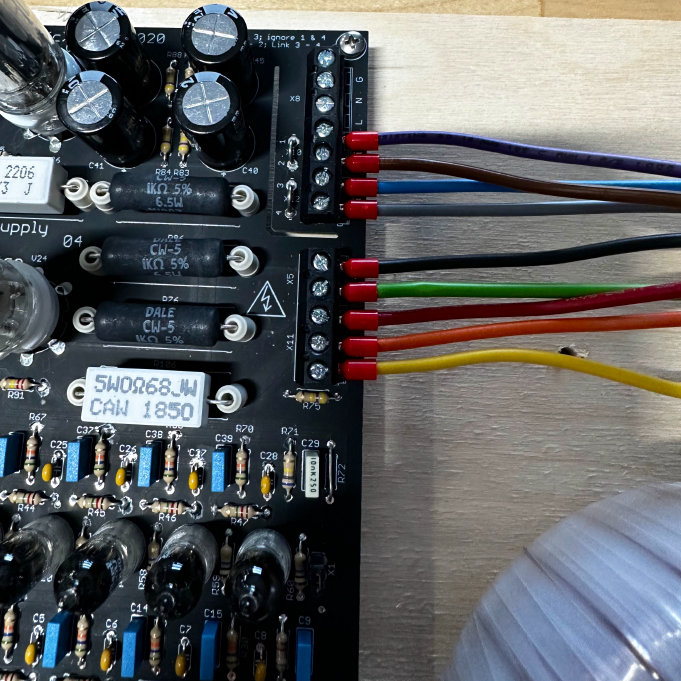
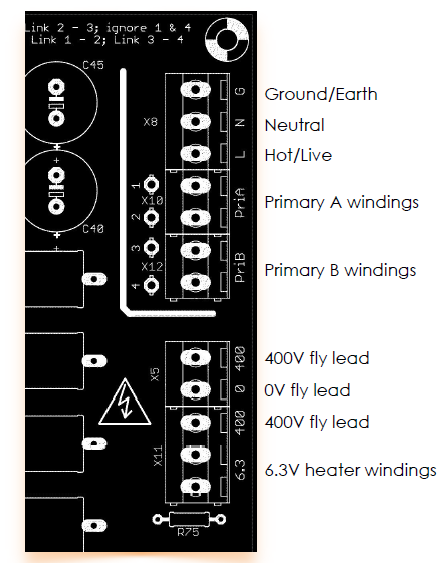
The transformer wiring is pretty straightforward, just follow the markings on the board (dual primary winding transformer shown here). Mains input wiring should be derived from a filtered IEC type socket. Make sure the links between 1 to 4 are appropriate for the mains voltage/transformer used (115V AC operation shown). Note the bootlace ferrules used to terminate the fly leads, these aren't absolutely necessary, but recommended.
Colon Tube Options
Some individuality can be employed in wiring the colon neons. (The colon neons act as separators between the hours and minutes nixies, and the minutes and seconds nixies). Here are some wiring options. Boards are available for single or dual MTX90s.
Click for a larger image:
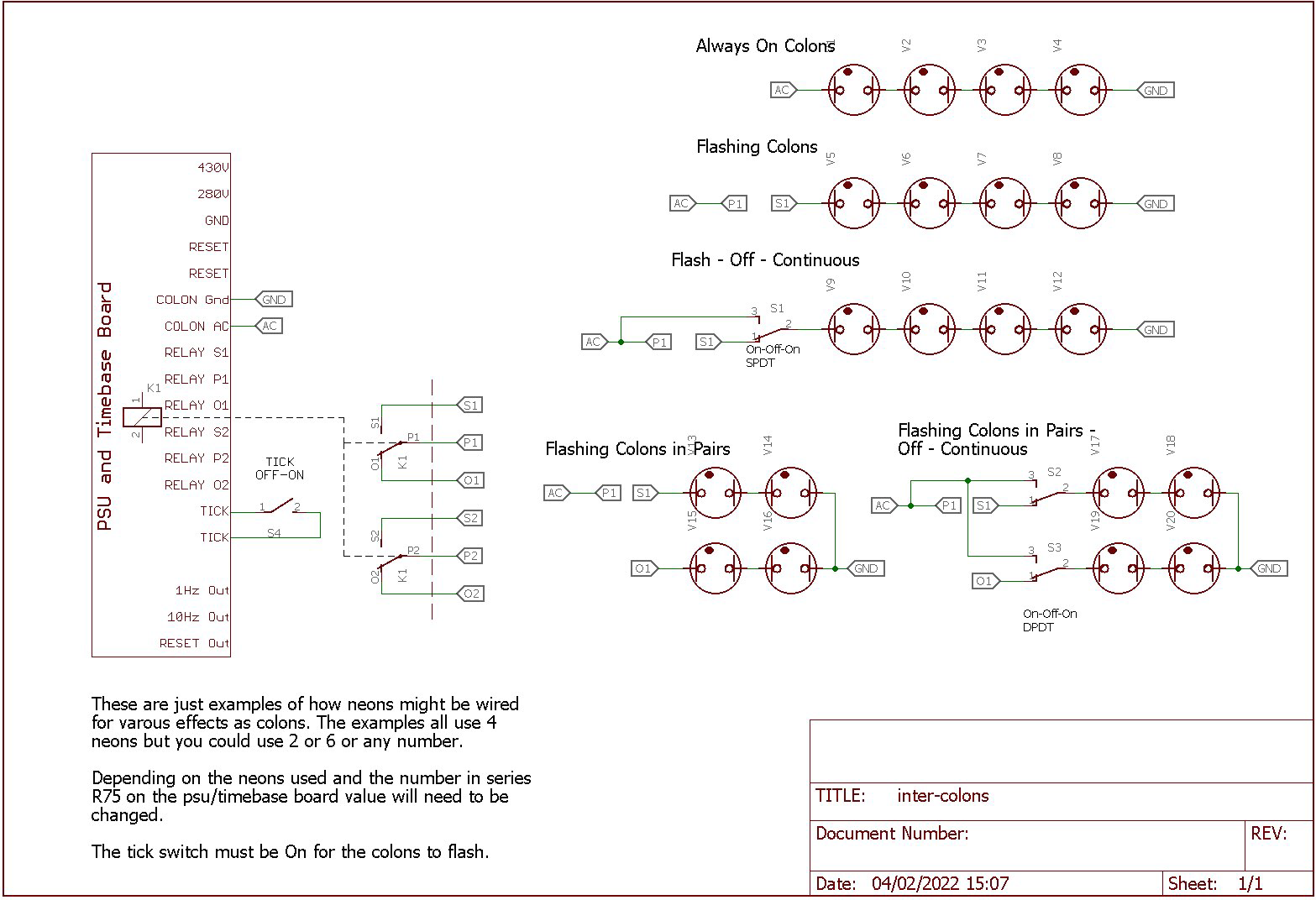
Nixie Tube Options
Changing the type of nixie tubes that the clock will operate with is not a simple operation. The clock was designed to use Z560M type tubes and the common Z700U series anode resistor (180kΩ) and the nixie anode resistor (27kΩ) have been determined to work well. If you have a nixie tube that needs about 170V and the segment current is around 2mA then these values should work for you. This does encompass a lot of reasonable sized end view tubes like the GN4/Z560/B6091/LC516 etc.
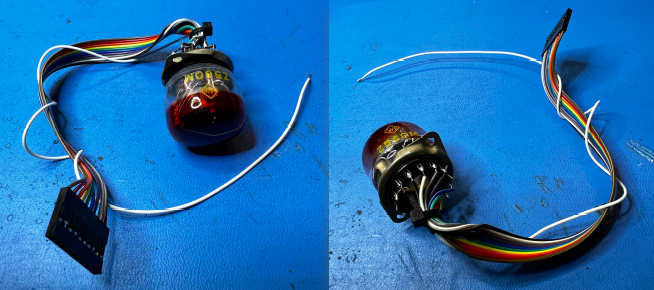
Here's an example of a Z560M tube wired up to a DuPont connector, the white lead is the anode and there's a 27kΩ resistor wired in series with it at the socket. How you mount your nixies/colons is entirely up to you and your case design.
Clock Longevity
Trigger Tube Life
The Phillips Z70U booklet says "The life expectancy in counting circuits is longer than 30,000 hours" or about 31/2 years. If this is the actual time ignited then the following must be considered:- On the PSU and Timebase board the tick-tock flipflop trigger tubes and pulse shaper tubes are each ignited 50% of the time
- On the hours count/display card the "0" and "1" hour trigger tubes are each ignited about 42% of the time
- All the remaining trigger tubes are ignited for <20% of the time
Little can be done to extend the life of the trigger tubes therefore it is recommended that a few spare tubes are purchased to guard against future unavailability.
Nixie Tube Life
In modern microcontroller based clocks steps can be taken to extend tube life such as using a PIR to turn them off when no one is around or timing the clock to go on/off at preset times. This clock is far more primitive and little can be done by the clock itself to extend tube life. The following might be considered:
- Ensure the tubes operate at the correct current and adjust the anode resistor value as necessary
- Occasionally rotate tube positions that are fully used (all the units nixie tubes) with those where not all of the cathode are used(all the tens nixies)
Relay Life
The relays used have a mechanical operating life exceeding 20e6 cycles. The hour relay cycles only once per day suggesting a life exceeding 55,000 years - good enough. The tick-tock relay cycles every 2 seconds which gives a life exceeding only 1¼ years. There are several ways forward:
- Do nothing - other references suggest actual mechanical operating life of a relay should exceed 1e9 cycles or over 60 years in this duty
- Turn of the tick-tock when not required to extend the life
- Expect the relay to fail; this is why we recommend using 8 small MillMax receptacles to enable the relay to be plugged into the board for easy replacement
Vacuum Valves and Stabiliser Tubes
These components will wear with time and must be expected to fail eventually. The valves and stabiliser tubes used have long lives, many equivalents and are readily available from specialist suppliers and on eBay. No action should be necessary but purchase a spare set if you wish. Remember, a well ventilated case will also lead to longer lifespan of heat sensitive electronics.
Switches
You have all these boards wired up but you need appropriate switches wired to control all the aspects of the clock, run/set, reset, minutes setting, hours setting, tick/tock, maybe colons on/off/flash etc. A quick primer to some common types of switches (these can also come in momentary options too - denoted by a bracket).

The question arises, which switches do you need for the trigger tube clock? Depending on what kind of case you're going to make it's nice if you can find a family of switches that is not only appropriately rated for voltage insulation (remember, some of these switches have high voltage on them), but also they offer the types needed. We found the MCR13-28 switch family from Multicomp Pro to fit the bill. Even though these are rated at DC500V insulation, the switches should be mounted on a grounded metal plate of some form to be extra safe.

Clock Add-Ons
There are a few extra boards and items that can be added to the trigger tube clock. Currently these are:
- 10ths of seconds board (eye candy)
- Simple Dekatron spinner (more eye candy)
- Complex Dekatron spinner/pendulum (even more eye candy with more switches!!)
- Case fan (keep things cool)
- High voltage meters (subtle eye-candy)
10ths Seconds Board
This adds a 7th nixie to the line up. The nixie cathode changes every 1/10th of a second so it whirls like a dervish.
Wiring of the tenths of seconds board is straightforward too. The input is fed from the 10Hz output of the PSU/Timebase board and the reset, 430V and GND lines can be fed from either the main board or from the other minutes/seconds or hours board, depending on what is easiest with your wiring setup.

Wiring of the nixies is identical to the other boards using the same series anode connection from the 430V connector on the 10ths second board.
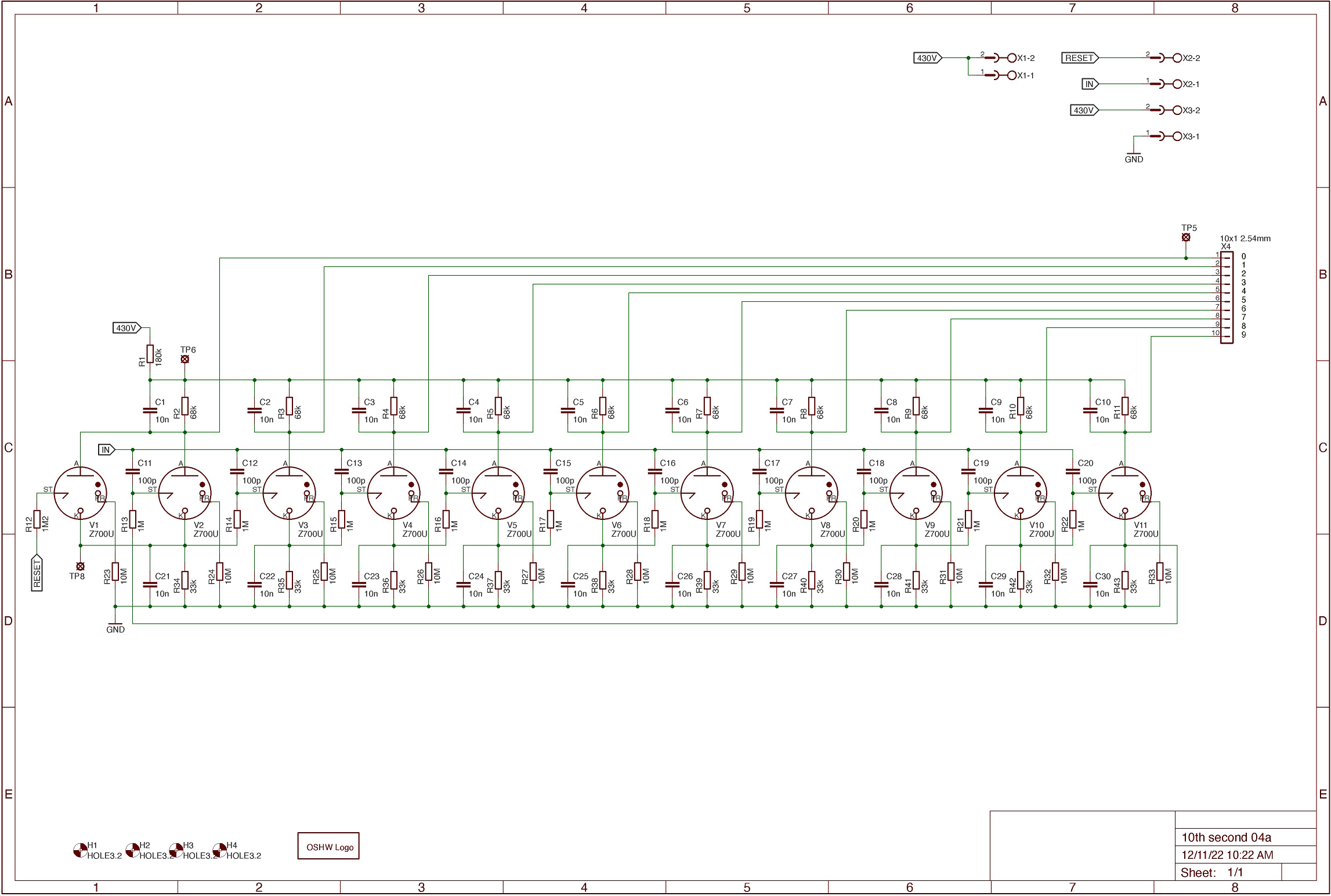

Dekatron Spinner
Add some neon spinning dekatron goodness to the clock along with yet another trigger tube.
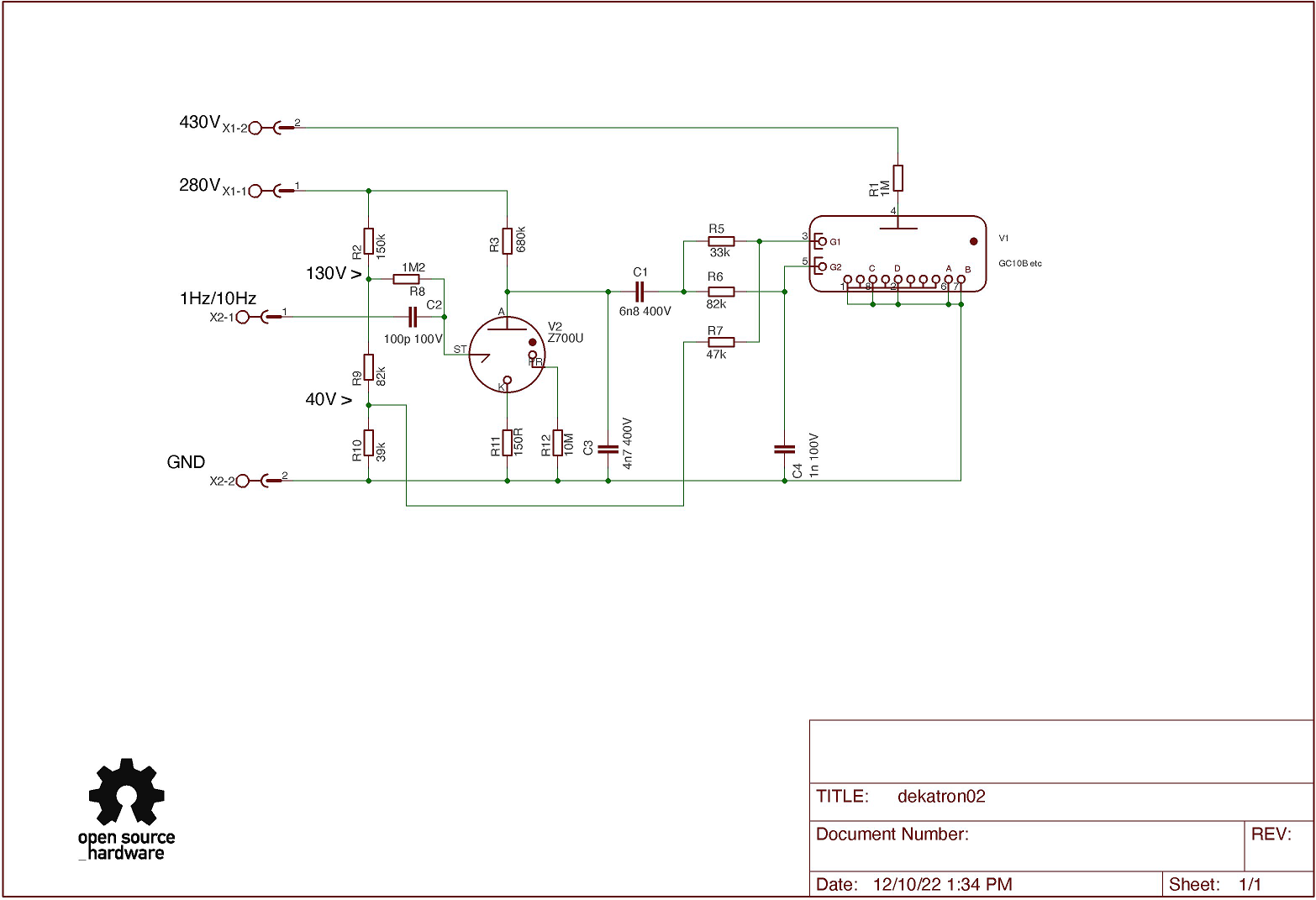
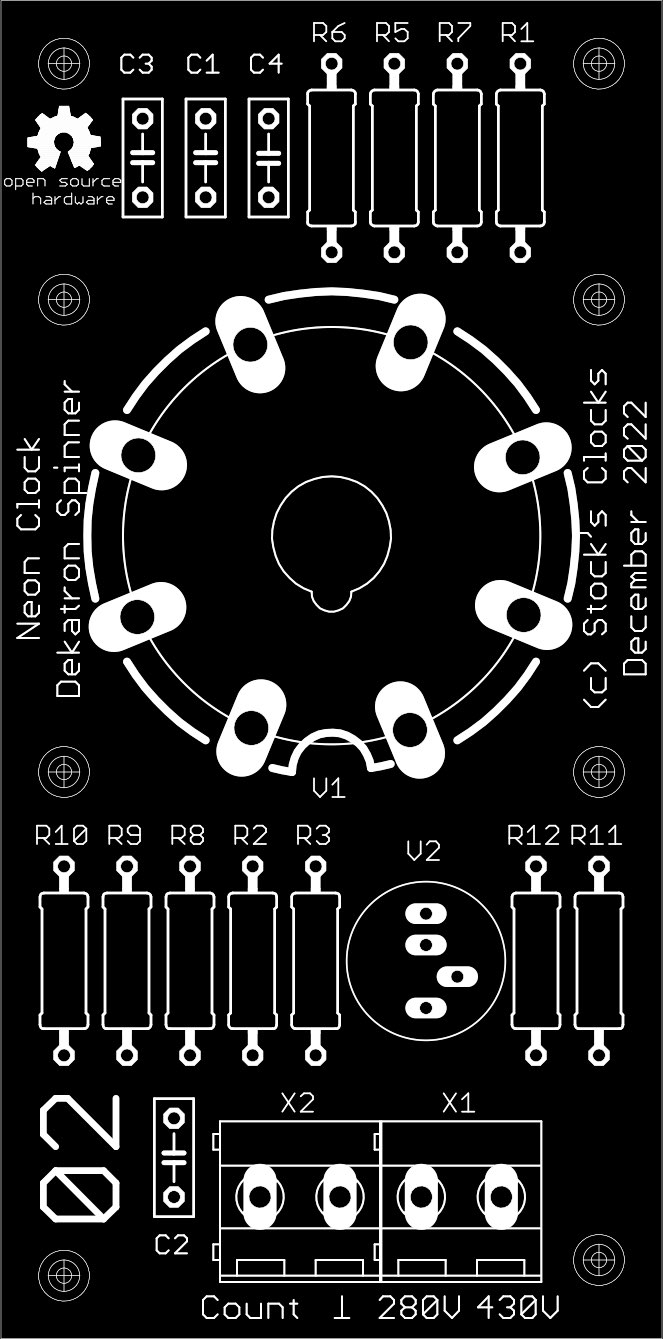
Dekatron Spinner and Pendulum
Under development!
Case Fan
The clock generates a considerable amount of heat. Especially from the PSU area. If you are intending on using a case with no natural convection then you should consder using a small equipment fan to force ventillate the enclosure.
High Voltage Meters
There is no technical reason why you need a read-out of the voltages generated by the PSU. But there are some quite pretty meters available - second hand, NOS and brand new. All good fun.
Documentation
Schematics and Layouts
You should look in the "/Nixie Projects/All Tube Trigger Clock 3" folder.
Quick LinksAnnex I Trigger Tube Circuits
About
Although the cold cathode diode is sometimes used as a counter device, for the majority of applications it suffers from one or more of the following shortcomings:
- the breakdown potential is not a controlled characteristic
- striking may be subject to statistical delays
- input and output share the same pair of terminals.
Several kinds of three- and four-electrode tubes are available which eliminate some or all of these shortcomings. In construction, they vary considerably, but in principle they represent a simple logical development from the neon diode. The main anode-cathode gap of a such a tube has all the characteristics of a gas-filled diode. If the applied voltage exceeds a given value, Vig, ignition or breakdown occurs. As long as the current is restricted to the range corresponding to a normal glow discharge, the maintaining voltage, Vm, is substantially constant. As in a simple diode, breakdown cannot occur unless free electrons or ions are present in the gap. Photoemission or ionisation by natural radiation or a radioactive isotope in the envelope produce ion currents so small that the breakdown voltage is not usually dependent on their magnitude. As a rule, only direct sunlight will produce sufficient photoemission to reduce the value of Vig. In a cold cathode triode, however, the additional electrode provides an alternative means whereby a substantial ionisation of the main gap may be produced. When a sufficiently high potential is applied between this trigger electrode and cathode, a discharge occurs between these two electrodes. Provided the trigger current exceeds a critical value known as the transfer current, sufficient ionisation of the main gap is produced to promote a discharge from anode to cathode. This occurs even though the anode voltage is less than Vig, but it must, of course, be greater than the maintaining voltage, Vm, to which the anode voltage falls once ignition occurs.
Figure: Z700U Construction

The trigger gap also has the characteristics of a cold cathode diode, and accordingly, it, too, cannot strike without a source of primary electrons. In a trigger tube it is usually required that triggering shall occur as quickly as possible once the appropriate potentials have been applied. Accordingly, natural radiation cannot be relied upon to produce primary ionisation, as considerable delays would frequently arise between application of the trigger potential and ionisation of the gas filling by a cosmic ray. Even the inclusion of a radioactive material, such as uranium oxide or tritium, leaves a significant statistical delay. Accordingly, two alternative types of trigger tube have been evolved:
- Those in which the cathode is coated with a material of low work function, e.g. an oxide of barium or potassium. Such a coating will emit electrons under the influence of light entering the glass envelope. These electrons then provide the primary ionisation neces-sary for triggering to occur.
- Tubes using pure metal cathodes, usually molybdenum. The pure metal has a higher work function than an oxide coating, and as a result its photoemission is confined to ultraviolet wavelengths in the band absorbed by the glass of the tube envelope. Consequently, photoemission due to external radiation cannot be used to produce primary ionisation. An alternative source is provided in a small continuous priming discharge across an auxiliary electrode gap. An external series resistor is used to restrict this discharge to some tens of μA, and this low current is not itself enough to cause triggering of other interelectrode discharges. Some ions or photons do, however, enter the trigger-cathode gap, and so provide primary ionisation allowing triggering to occur as soon as the trigger-cathode breakdown voltage, Vt, is reached.
One sees that the trigger tube when called a "relay" tube is most aptly named. Application of the requisite trigger potential allows the photoemission or priming discharge to initiate breakdown of the trigger-cathode gap. Discharge of the trigger circuit in turn supplies the greater degree of primary ionisation needed to cause ignition of the main gap at an anode voltage below Vig. Ionisation is thus "relayed" from primary source to main gap once the trigger potential reaches Vt. This justification of the name relay tube is only incidental: its true origin lies in the considerable power gain between input and an "off-on" output.
Ignition Characteristics
Figure: Characteristics of a typical trigger tube, indicating electrodes between which initial breakdown occurs
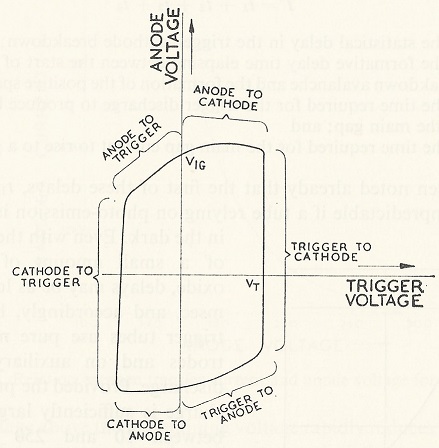
This figure represents the ignition characteristic of a typical trigger tube. Provided the voltage applied to the trigger electrode and anode are represented by a point lying within this characteristic, ignition does not occur. If one or both of these voltages is increased until the working point reaches or passes outside the characteristic, breakdown occurs. Operation is usually confined to the first quadrant, and breakdown is then initially between trigger and cathode or anode and cathode, depending on whether it is the trigger voltage or the anode voltage which is increased to move the working point beyond the characteristic. It will be seen, however, that if the trigger and/or anode voltage can become sufficiently negative the initial breakdown will occur in either direction between any pair of electrodes. With many circuits, particularly those operating with A.C. supplies, such triggering can occur unintentionally and must be guarded against. If current flows into the nominal anode or trigger some of the nickel may be sputtered on to the normal cathode, hereby contaminating the cathode surface. In tubes having pure metal cathodes this produces a permanent change in the otherwise very stable triggering characteristic of the tube.
Once breakdown occurs, the anode voltage falls to the anode-main-Inkling voltage, Vn. The trigger then acts as a probe in the anode-cathode discharge and tries to assume the trigger maintaining potential, Vn. This it will do provided the trigger current is limited to a few μA by a sufficiently large resistance in the trigger circuit. It should be noted that reverse trigger current will flow if the trigger supply potential is allowed to fall below Vn while the anode gap is conducting.
Triggering does not occur instantaneously. Between application of the trigger pulse and the establishment of anode current a delay time T arises which is the sum of:
- the statistical delay in the trigger-cathode breakdown
- the formative delay time elapsing between the start of the trigger breakdown avalanche and the formation of the positive space charge
- the time required for the trigger discharge to produce breakdown of the main gap; and
- the time required for the main gap current to rise to a given level.
It has been noted already that the first of these delays becomes long and unpredictable if a tube relying on photo-emission is operated in the dark. Even with the inclusion of a small amount of uranium oxide, delays may be as long as 100 msec, and accordingly, high-speed trigger tubes use pure metal electrodes and an auxiliary priming discharge. Provided the priming discharge is sufficiently large (usually between 10 and 250 μA), the statistical variation in practically disappears.
Trigger Tube Circuits
Having provided some general blurb on how trigger tubes operate, it is time to look at some practical but simple circuits used in the clock. Circuits to ignite and extinguish a trigger tube, and then how these are combined to form more complex circuits. In particular, reset circuits and ring/chain counters will be described as they are used throughout the clock.
Igniting Trigger Tubes
There are a variety of methods that can be used to trigger the tube ignition. The technique used in clock are current triggering and pulse-plus-bias triggering. The other technqiues that have been developed will be ignored here.

(a) Current Triggering
It is a pre-requisite that Vs > Vt. There is then a relationship between the tube parameters, Vs and the value of Rt. In practice Vs can be much larger than Vt to ensure triggering.
(b) Pulse-Plus-Bias Triggering
A positive bias, Vs, is applied which is sufficiently less than Vt so that no triggering occurs. A positive going pulse Vp is applied through capacitor Cp, which again, in itself is insufficient to ignite the tube. However, when the bias is applied and then the pulse applied triggering can be made to occur. This can be compared to a logic 'AND' gate. However, pulse-plus-bias triggering is better described as bias-before-pulse triggering. It is essentially a logical process of 'A' before 'B' rather than a true 'AND' gate.
Extinguishing Trigger Tubes
The methods by which a trigger tube may be extinguished are similar to those available for a diode. In trigger tubes, however, the anode-cathode and trigger-cathode discharges must both be extinguished.
(a) Series-switched Extinguishing

The simplest way of extinguishing a cold cathode tube comprises opening a switch in the +H.T. supply.
(b) Common-anode-load Extinguishing

Although other arrangememts are possible, a common arrangement comprises shunting the cathode resistors, Rk1 and Rk2, by suitably large capacitance, Ck1 and Ck2. While V1 is conducting, Ck1 charges to an equilibrium value. When V2 is triggered the cathode of V1 is held positive by Ck1, while that of V2 is initially at ground because Ck2 has yet to charge up. If the circuit time-constants are correctly chosen, V1 cathode will remain above V2 cathode long enough for V1 to deionise.
(c) Common-cathode-load Extinguishing
This arrangement is identical to the common-anode-load methode except the common resistor is in the cathode circuit.
(d) Self-Quenching
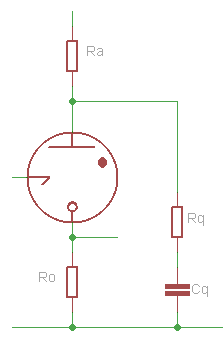
A trigger tube may be made self-quenching by using an appropriate series resistance, Ra, and shunt capacitance, Cq. When the tube strikes, the voltage across the gap falls to its maintaining voltage. The capacitor discharges rapidly, producing heavy ionisation of the tube. Consequently, although no further ionisation takes place once the gap voltage has fallen to the maintaining voltage, the removal of ions from the gap constitutes a continued flow of current. If this exceeds the current flowing in the series resistor the capacitor will be discharged below the normal maintaining voltage. As the ion current decreases, the capacitor will begin to recharge. Provided that it takes longer than the deionisation time to reach the gap voltage for which is the deionosation time is quoted, the discharge will not immediately restrike.
A resistor, Rq must be connected in the capacitor discharge path to limit the peak discharge current to a value which will not damage the tube.
A cathode series resistor, Ro, is also used to develop a positive output pulse at low impedance. Thus a self-quenching discharge may be used to generate sharp, low-impedance pulses that can be used to apply pulses simultaneously to the triggers of a number of tubes, as in pulse-plus-bias triggering.
Chain and Ring Counters
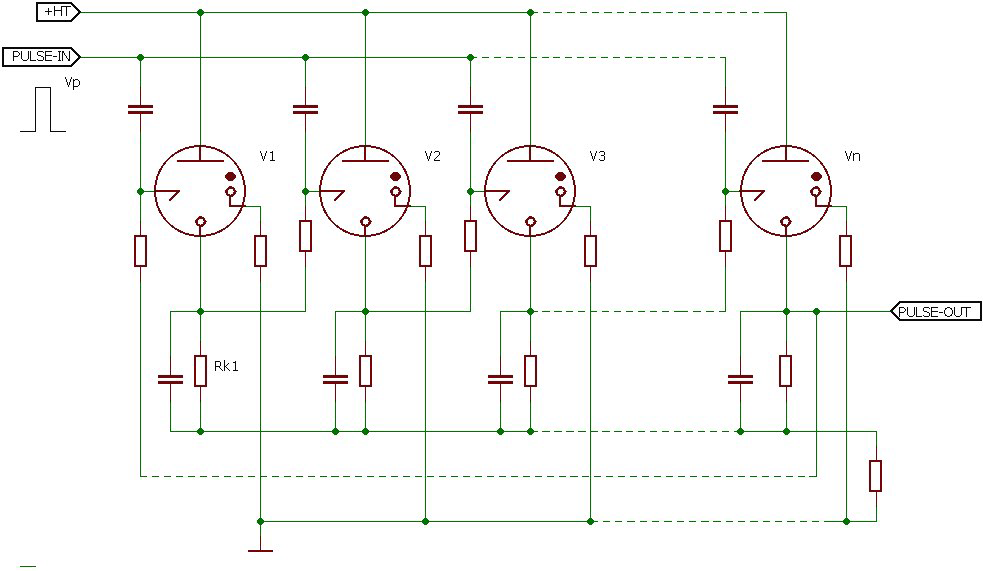
This figure is representative of a class of counting circuit based on pulse-plus-bias logic. A chain of n similar stages is often formed into a closed ring by connecting Vn to V1 in the same way as V1 is connected to V2 and V2 to V3. Common-anode-load extinguishing ensures that only one tube conducts at a time.
Suppose V1 is conducting. The voltage drop across Vk1 raises the trigger of V2 to a little below triggering potential. The triggers of all other tubes are at earth potential. When a positive-going pulse Vp is applied simultaeously to all triggers it follows that V2 will fire but providing that Vp < tube trigger voltage, none of the other tubes will fire. Firing of V2 quenches V1 and applies a priming bias to V3. Thus at the next pulse V3 will strike and V2 extinguish.
Positive-going outputs may be taken from the cathodes of individual tubes in the ring or chain.
Reset Circuits
In practical applications it is often needed to set the state of counters, flip-flops etc when the equipment is first switched on, or to reset to this staring state when the equipment is running. The chain or ring counter is an example where reseting the count to '0' is often required.

This example of a reset circuit uses a additional trigger tube, V0, in parallel with the first counter tube, V1. When a pulse, Vreset, is applied to the trigger of V0 causing it to ignite, the counter tubes are extinguished and the reset tube is left burning. When the next counter pulse, Vp, is applied, V0 will be extinguished and V2 will ignite.
Application of these circuits
This ring/chain counters and reset circuits are used throughout the clock:
- Pulses at mains frequency are fed into a ring of n=5 for 50Hz mains (or n=6 for 60Hz mains). One output pulse is generated by V5 (or V6) for every 5 (or 6) unit pulses. These pulses will be at a frequency of 10Hz.
- Pulses at 10Hz are fed into a ring of 10 tubes so the output pulses will be at a frequency of 1Hz.
- A ring of 10 tubes and then of 6 tubes will count 60 seconds and produce one output pulse every minute. The output pulse is taken from the cathode of V6 in the second ring so that it is produced at the same time that the seconds count changes from "59" to "00".
- The minutes rings are identical to the seconds rings and one output pulse is produced per hour.
- A ring of 10 and then a chain of 3 (i.e. with no feedback loop) are used to count hours and, for a 24 hour clock, both rings must be reset to 00 when the rings try to step to "24". Some extra logic is neede to detect this.
Each ring or chain counter has a reset circuit.
Quick LinksAnnex II J.B. Dance says
In Chapter 3 of Electronic Counting Circuits by J.B. Dance (Iliffe Books Ltd 1967) it says:
3. Single Cathode Gas Filled Counting Tubes and Their Circuits
…
3.4.7 Digital Readout from Trigger Tube Circuits
Although trigger tubes are inherently self indicating, it is usually much more convenient to use one digital indicator tube per decade to display the state of the count than to observe the ten trigger tubes in each decade themselves. The indicator tubes display one digit each as a neon glow. They have one common anode and the current passes from this to any one of ten cathodes. Each of the cathodes has the shape of one digit. One cathode is covered by a red glow when the tube is operating. Further details of digital indicator tubes are given in Chapter 10.
The digit which is being displayed at any specified time is determined by which cathode is passing current at that time. The selection of this cathode is carried out by the counting circuit itself. Each trigger tube in the decade circuit is connected to one of the ten indicator tube cathodes. When a particular trigger tube is conducting, the circuit must be arranged so that the corresponding cathode of the indicator tube is at a lower potential than that of the other indicator tube cathodes. The tube then indicates the appropriate number corresponding to the number of the trigger tube in the ring.
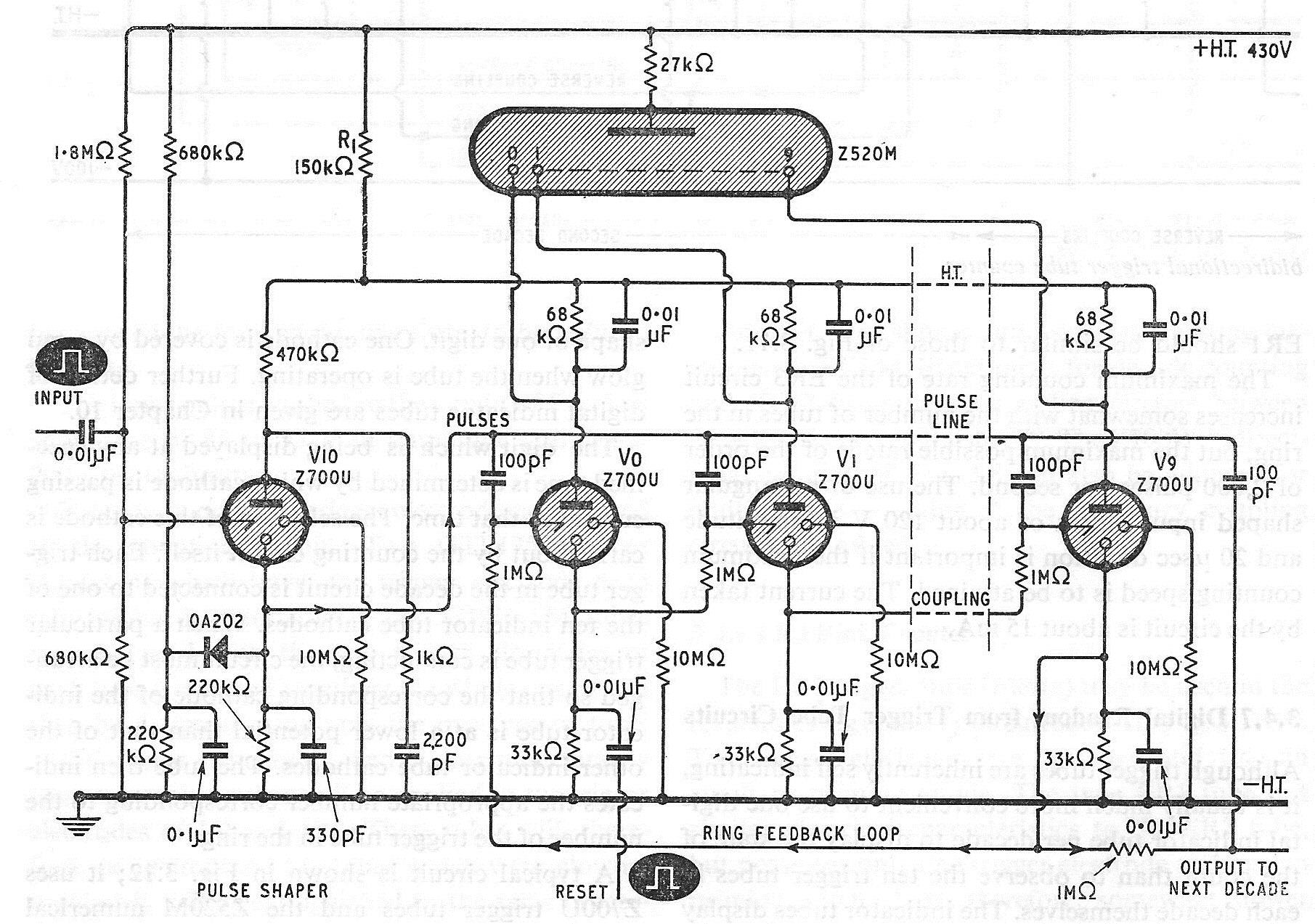
Fig. 3.12 A Z700U decade counter with Z520M readout
A typical circuit is shown in Fig. 3.12; it uses Z700U trigger tubes and the Z520M numerical indicator tube. The Z700U trigger tube V10 in the input circuit of Fig. 3.12 converts any incoming pulses into pulses of a suitable amplitude and duration for the operation of the other ten Z700U tubes which perform the counting operation. Pulses from the cathode of V10 are fed along the pulse line to the trigger electrodes of the counting tubes via 100 pF capacitors. The V10 circuit has a capacitor between the anode of the tube and earth and is, therefore, self extinguishing.
The counting tube anodes are fed through the common anode load resistor marked R1 (150k). In addition a smaller resistor (68k) is included in the anode circuit of each individual tube. These resistors are necessary for the operation of the indicator tube, but are by-passed by capacitors so that they do not affect the counting operation itself. The cathodes of the Z520M tube which are not shown in Fig. 3.12 as being connected to any particular trigger tube anode are actually connected to the trigger tubes in between V1 and V9; these trigger tubes have been omitted for simplicity.
If a trigger tube is conducting, its anode will be at a lower potential than the anodes of the other counting tubes owing to the flow of anode current through the 68k anode resistor. There will therefore be a greater voltage between the Z520M anode and the cathode of the Z520M which is connected to the conducting trigger tube than between the Z520M anode and any other cathode. Thus the cathode which is connected to the conducting trigger tube becomes the preferred cathode for the discharge and the Z520M indicates the corresponding number.
The common anode resistor, R1, enables a tube to be extinguished when the discharge is transferred to a succeeding tube by the same mechanism as that discussed previously in connection with the circuits of Figs. 3.5 and 3.7.
If a suitable negative pulse is applied to the cathode of VO via the 0.01u capacitor, the discharge will be transferred to VO and thus the decade will have been reset.
The maximum counting speed will be similar to that of the circuit of Fig. 3.8. If desired, Z700W tubes could be used for reversible counting with the Z520M as indicator. A circuit similar to that shown in Fig. 3.12 should be used with the additional trigger electrodes of the Z700W tubes arranged so that the circuit is symmetrical in both the forward and reverse directions.
…
